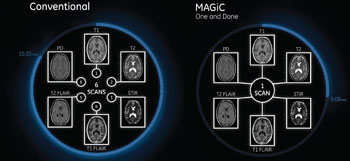Multi-Contrast MRI Technique Reduces Scan Times
By MedImaging International staff writers
Posted on 20 Oct 2016
An innovative multi-contrast magnetic resonance imaging (MRI) technique can manipulate scans retrospectively, leading to significant timesaving and fewer rescans.Posted on 20 Oct 2016
The MAGnetic resonance image Compilation (MAGiC) acquisition technique allows clinicians to modify image contrast after scanning has been completed, which is not possible with conventional imaging. While with conventional MR imaging, a radiologist may need to order a rescan if the proper contrast was not acquired, MAGiC allows the radiologist to view multiple different contrasts acquired from just a single scan, enhance differential diagnosis at a fraction of the scan time, improving patient throughput and comfort.

Image: A comparison of conventional and MAGiC MRI (Photo courtesy of GE Healthcare).
Clinicians will be able to generate multiple image contrasts in T1, T2, STIR, T1 FLAIR, T2 FLAIR, Dual IR, Phase Sensitive IR, and Proton Density weighted images of the brain, all in a single acquisition. To change contrast, users simply move a cursor on the interface to change parameters, such as repetition time (TR), echo time (TE), and inversion time (TI). MAGiC can also generate parametric maps for further analysis of patient-specific tissue values like T1, T2, and proton density (PD). MAGiC was developed by GE Healthcare (Waukesha, WI, USA), in collaboration with SyntheticMR (Linköping, Sweden).
“MAGiC is a terrific clinical innovation…this technique can improve the way clinicians conduct neuro scans and diagnose their patients,” said Eric Stahre, president and CEO of MRI at GE Healthcare. “Neuro scans are approximately 30% of all MR scans; therefore MAGiC could have a tremendous impact on the MR community. GE Healthcare is committed to delivering industry-leading MR innovations that advance clinical care.”
“MAGIC simultaneously provides a new level of protocol efficiency and tissue characterization,” said professor of radiology, neurology, and neurosurgery Howard Rowley, MD, of the University of Wisconsin (Madison, USA). “The flexibility to post-process a wide variety of key image families with different tissue contrasts from a single acquisition is groundbreaking. This will be a major advance for fast brain protocols and patient comfort due to the reduced scan time.”
Related Links:
GE Healthcare
SyntheticMR














